简单的多条折线图
小伙伴写过多条折线图的都知道,
常见的折线图是 xAxis 配置项下的 data属性上设置时间或者日期。
series配置项下是对应的 legend中的数据以及该条折线的数据。
多条折线图
let myChart = echarts.init(document.querySelector('div'))
// 设置X轴的时间
let dataXTime = [
'2023-12-04 09:45:07', '2023-12-04 09:50:07','2023-12-04 09:55:07', '2023-12-04 10:00:07', '2023-12-04 10:05:07',
'2023-12-04 11:05:07','2023-12-04 12:05:07','2023-12-04 13:05:07','2023-12-04 14:05:07','2023-12-04 15:05:07',
]
let option = {
// 设置的是标题
title: {
text: '折线图'
},
tooltip: {
trigger: 'axis'
},
legend: {
data: ['Email', 'Union Ads']
},
// 网格间距设置
grid: {
left: '30px',
right: '60px',
bottom: '3%',
containLabel: true
},
xAxis: {
type: 'category',
boundaryGap: false,
data: dataXTime,
},
yAxis: {
type: 'value'
},
// 数据
series: [
{
name: 'Email',
type: 'line',
data: [120, 132, 101, 134, 90, 230, 210,90, 230, 210]
},
{
name: 'Union Ads',
type: 'line',
data: [220, 182, 191, 234, 290, 330, 310,9, 30, 110]
}
]
};
myChart.setOption(option);
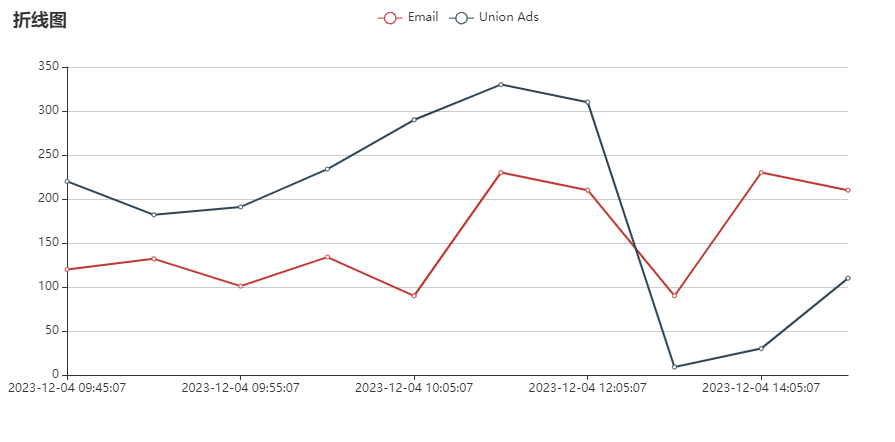
发现多条折线共享一个时间
通过上面的小例子,我们发现一个问题:
多条折线共享的是一个时间(时间与数据是1对多的关系)
第一个时间匹配第一个数据,第2个时间匹配第2个数据。
也就是第n个时间匹配第n个数据。
我们不仅会提出这样一个问题:
有没有可能让每一条折线拥有自己的时间呢?
时间不同,也可以显示在一个实例上。
多条折线拥有数据自己的时间
多条折线图
let myChart = echarts.init(document.querySelector('div'))
let option = {
// 设置的是标题
title: {
text: '折线图'
},
tooltip: {
trigger: 'axis'
},
legend: {
data: ['邮件', '短信']
},
// 网格间距设置
grid: {
left: '30px',
right: '60px',
bottom: '3%',
containLabel: true
},
xAxis: {
// xAxis的下不在设置data属性共享时间
type: 'category',
splitLine: { show: false },
lineStyle: {
width: 2
},
axisTick: {
show: false
},
axisLabel:{
// 更改x轴文字颜色的配置
textStyle: {
color: '#717782'
},
showMaxLabel: true // 固定显示X轴的最后一条数据
},
// 更改x轴线的颜色
axisLine: {
lineStyle: {
color: '#D2DBE6;',
width: 1 // x轴线的宽度
}
},
},
yAxis: {
type: 'value'
},
// 数据
series: [
{
"name": "邮件",
"type": "line",
"symbol": "rect",
"connectNulls": true,
"showAllSymbol": true,
// 让每一条折线拥有数据自己的时间
"data": [
[ "2023-12-04 09:50:07", "0.137"],
[ "2023-12-04 09:55:07", "0.147"],
[ "2023-12-04 10:00:07", "0.137"],
[ "2023-12-04 10:05:07", "0.163"],
[ "2023-12-04 10:10:07", "0.150"],
[ "2023-12-04 10:15:07", "0.143"],
[ "2023-12-04 10:20:07", "0.133"],
[ "2023-12-04 10:25:07", "0.147"],
[ "2023-12-04 10:30:07", "0.147"],
[ "2023-12-04 10:35:07", "0.143"],
[ "2023-12-04 10:40:07", "0.140"],
[ "2023-12-04 10:45:07", "0.150"],
[ "2023-12-04 10:50:07", "0.143"],
],
"unit": "%",
"markPoint": {
"symbol": "rect",
"symbolSize": "12",
"label": { "show": false },
"tooltip": { "triggerOn": "click", "trigger": "item" },
}
},
{
"name": "短信",
"type": "line",
"symbol": "rect",
"connectNulls": true,
"showAllSymbol": true,
"data": [
[ "2023-12-04 10:35:07", "0.123"],
[ "2023-12-04 10:40:07", "0.140"],
[ "2023-12-04 10:45:07", "0.150"],
[ "2023-12-04 10:50:07", "0.143"],
],
"unit": "%",
"markPoint": {
"symbol": "circle",
"symbolSize": "12",
"label": { "show": false }
}
}
]
};
myChart.setOption(option);
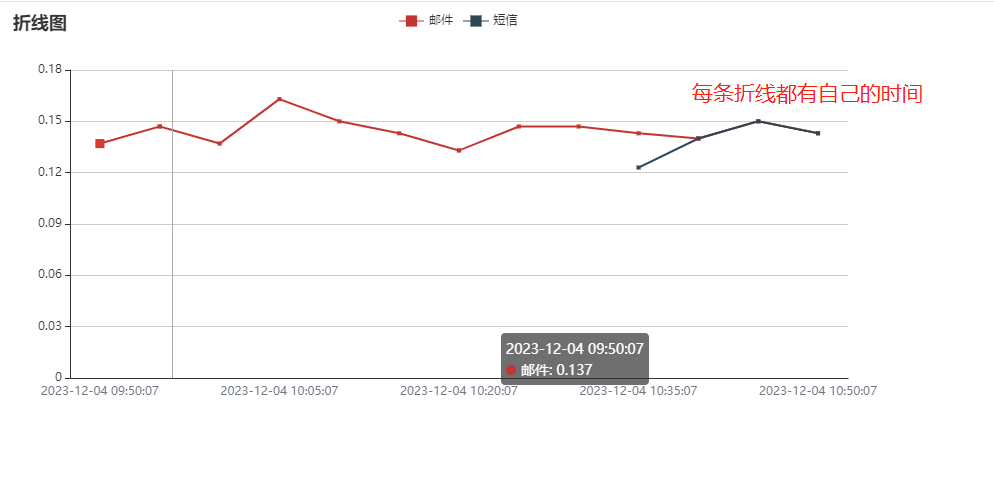
成功了吗?多条折线拥有数据自己的时间
根据上面的图片,我们发现。
好像确实是每一条折线都拥有数据自己的时间了。
但是如果你只细看的话。你就会发现端倪
结束时间都是一样的,但是折线却是在不同的时间上结束的。
很明显不正确的。

多条折线他们必须有一样的开始时间和结束时间?
上面我们发现了问题:结束时间都是一样的,但是折线却是在不同的时间上结束的。
有的机智的小伙伴可能会说:
是因为:多条折线他们必须有一样的开始时间和结束时间。
这样echarts在渲染的时候就不会出现上面这样的情况。
需要有相同的起始点和结束点
感觉有点道理,我们尝试一下
series: [
{
"name": "邮件",
"data": [
[ "2023-12-04 09:50:07", "0.137"],
[ "2023-12-04 09:55:07", "0.147"],
[ "2023-12-04 10:00:07", "0.137"],
[ "2023-12-04 10:05:07", "0.163"],
[ "2023-12-04 10:10:07", "0.150"],
[ "2023-12-04 10:15:07", "0.143"],
[ "2023-12-04 10:20:07", "0.133"],
[ "2023-12-04 10:25:07", "0.147"],
[ "2023-12-04 10:30:07", "0.147"],
[ "2023-12-04 10:35:07", "0.143"],
[ "2023-12-04 10:40:07", "0.140"],
[ "2023-12-04 10:45:07", "0.150"],
[ "2023-12-04 10:50:07", "0.143"],
],
},
{
"name": "短信",
"data": [
[ "2023-12-04 09:50:07", "0.8"],
[ "2023-12-04 10:40:07", "0.140"],
[ "2023-12-04 10:45:07", "0.150"],
[ "2023-12-04 10:50:07", "0.143"],
],
}
]
现在都有相同的起始点(2023-12-04 09:50:07)和结束点(2023-12-04 10:50:07)。

如果每条折线的时间都没有交集会怎么样?
我们发现只要有相同的起始点和结束点;
就会可以达到我们的预期效果。
此时,有的小伙伴说:
"如果他们的时间如果没有交集会怎么样(有相同的起始点和结束点)"
"data": [
[ "2023-12-04 09:50:07", "0.137"],
[ "2023-12-04 09:55:07", "0.147"],
[ "2023-12-04 10:00:07", "0.137"],
[ "2023-12-04 10:05:07", "0.163"],
[ "2023-12-04 10:10:07", "0.150"],
[ "2023-12-04 10:15:07", "0.143"],
[ "2023-12-04 10:20:07", "0.133"],
[ "2023-12-04 10:25:07", "0.147"],
[ "2023-12-04 10:30:07", "0.147"],
[ "2023-12-04 10:35:07", "0.143"],
[ "2023-12-04 10:40:07", "0.140"],
[ "2023-12-04 10:45:07", "0.150"],
[ "2023-12-04 10:50:07", "0.143"],
],
"data": [
[ "2023-12-04 09:50:07", "0.8"],
[ "2023-12-04 09:52:07", "1.23"],
[ "2023-12-04 10:41:07", "0.140"],
[ "2023-12-04 10:49:07", "0.150"],
[ "2023-12-04 10:50:07", "0.143"],
],
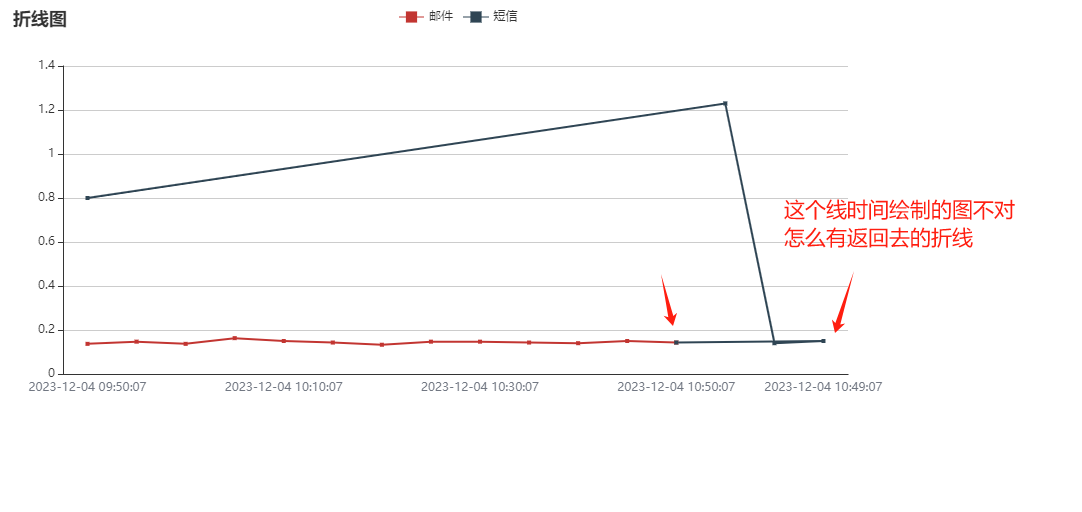
xAxis 的 type值设置time
时间绘制的折线图不对,怎么会有返回去的折线?
怎么去解决这个问题呢?
有些小伙伴又提出了。我们可以将 xAxis 的 type值设置time。
就可以解决这个问题。
在 ECharts 中,type的值是 time 和 category 的区别
1.数据类型:'time' 表示时间类型的数据,适用于连续的时序数据。
通常返回的是时间戳。我们为了方便这里写的是yyyy-mm-dd hh:mm:ss
而 'category' 表示类目类型的数据,适用于离散的类目数据。
2.显示方式:在 'time' 类型下,
ECharts 会根据时间跨度自动切换显示的时间粒度,例如从月、星期、日到小时等。
而在 'category' 类型下,坐标轴只会显示类目列表,并且坐标轴内仅包含这些指定类目的坐标。
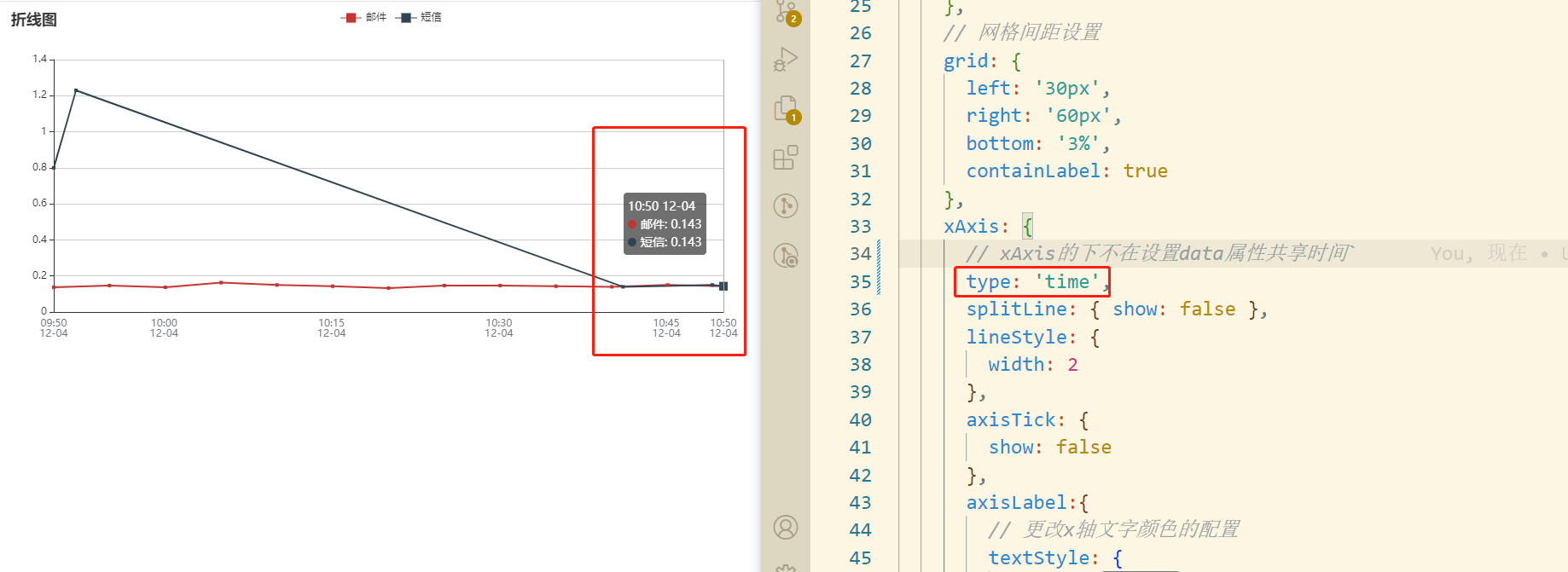
时间格式又不对
有眼尖的小伙伴发现了一个小问题。
我们给的时间是 yyyy-mm-dd hh:mm:ss的格式
但是刚刚发现展示的是 hh:ss mm-dd
格式和我们预期的不符合

xAxis 配置项 axisLabel下的formatter 转换时间格式
通过查询echarts的文档。
我们发现 xAxis.axisLabel.formatter 可以做到对格式进行转换。
formatter:刻度标签的内容格式器,支持字符串模板和回调函数两种形式。
对于时间轴(type: 'time'),formatter 的字符串模板支持3种形式:
1.字符串模板:简单快速实现常用日期时间模板,string 类型
2.回调服务器托管网函数:自定义 formatter,可以用来实现复杂高级的格式,Function 类型
3.分级模板:为不同时间粒度的标签使用不同的 formatter,object 类型
我发现使用 字符串模板 模板是不行的。分级模板没有试过。
官网推荐使用字符串模板,如果可以使用成功。
我们就不需要在写一个方法进行转化了。
但是很遗憾,失败了。可能是用的方式错误吧
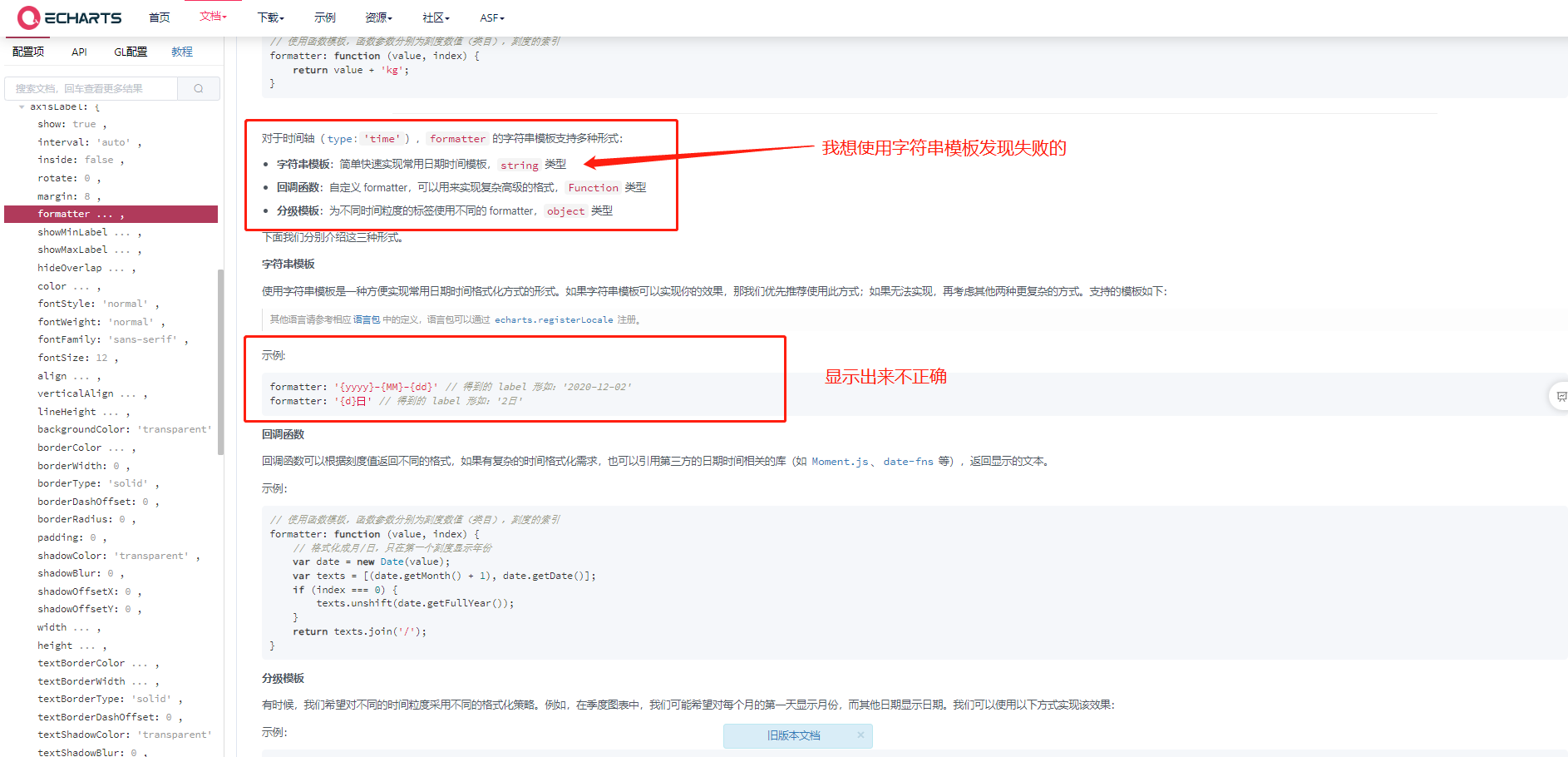
字符串模板是失败的

字符串模板是失败的原因
本来我已经失望了。
结果小脑袋灵光一闪,猜测有没有可能是版本的原因。
我果断去切换到5的版本
果然字符串模板显示正常了
模板字符串的详细使用地址是:https://echarts.apache.org/zh/option.html#xAxis.axisLabel.formatter
字符串模板转化时间格式【推荐】
xAxis: {
// xAxis的下不在设置data属性共享时间`
type: 'time',
splitLine: { show: false },
lineStyle: {
width: 2
},
axisTick: {
show: false
},
axisLabel:{
// 更改x轴文字颜色的配置
textStyle: {
color: '#717782'
},
// 设置坐标轴上的时间格式 --使用的是模板字符串
// formatter: "{yyyy}-{MM}-{dd}", 得到的 label 形如:'2020-12-02'
formatter: '{yyyy}-{MM}-{dd} n{HH}:{mm}:{ss}',
showMinLabel: true,
showMaxLabel: true // 固定显示X轴的最后一条数据
},
// 更改x轴线的颜色
axisLine: {
lineStyle: {
color: '#D2DBE6;',
width: 1 // x轴线的宽度
}
},
},

使用回调函数转化时间格式
function backTime(value){
let date = new Date(value);
// 获取年份、月份和日期
let year = date.getFullYear();
let month = date.getMonth() + 1; // 月份从 0 开始,需要加 1
let day = date.getDate();
let hours = date.getHours();
let minutes = date.getMinutes();
let seconds = date.getSeconds();
// 格式化月份和日期为两位数(不足两位时补零)
month = month 特别提醒: type: 'time'的时候,
formatter : function (value) { }
中的value是一个时间戳
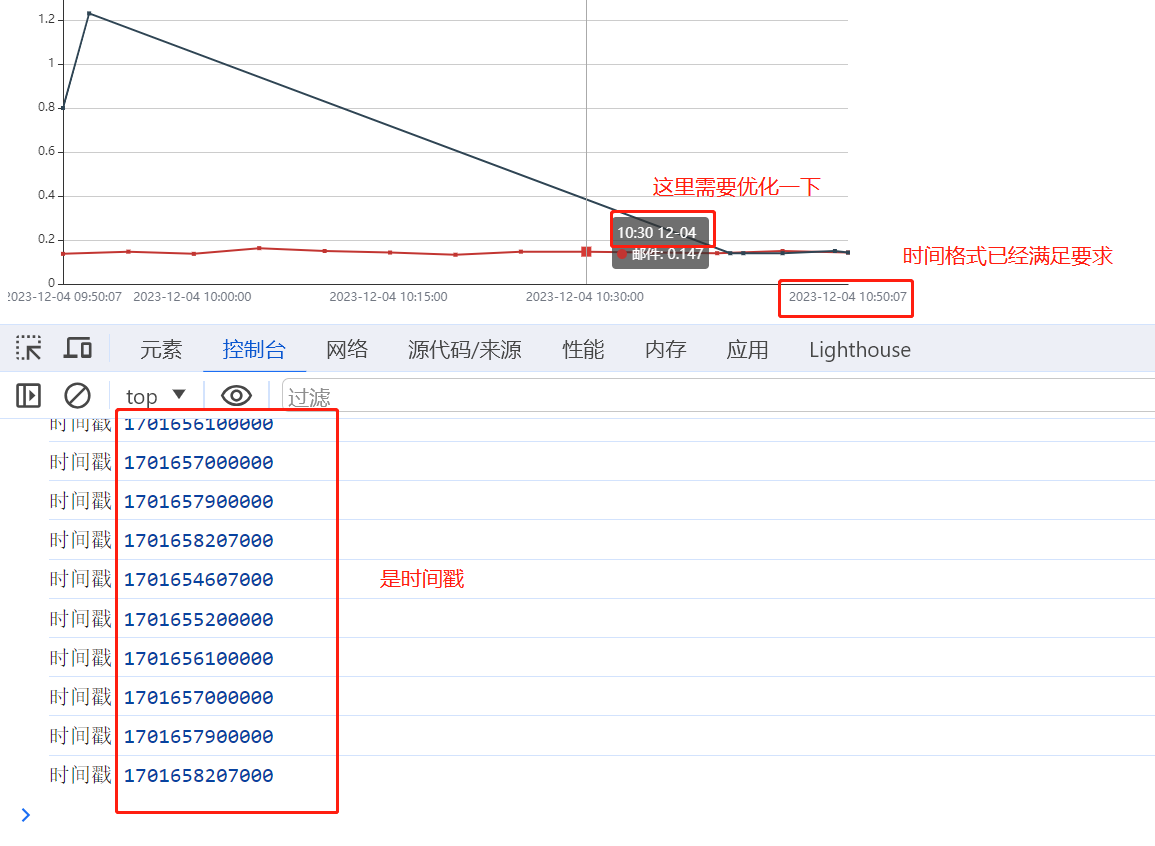
更改tooltip的时间格式
tooltip: {
trigger: 'axis',
formatter: (c) => {
let str = ''
let temp = {
showTime: '', // 时间
marker: '', // 颜色
seriesName: '', // legend名称
valueData: '', // 数值
setWidthSpan: '',
}
c.forEach((item) => {
temp.showTime = item.data[0]
temp.marker = item.marker
temp.seriesName = item.seriesName
temp.valueData = item.value[1]
temp.setWidthSpan = ''
str += temp.marker + temp.seriesName + temp.setWidthSpan + temp.valueData + '
'
})
return temp.showTime + '
' + str
},
},
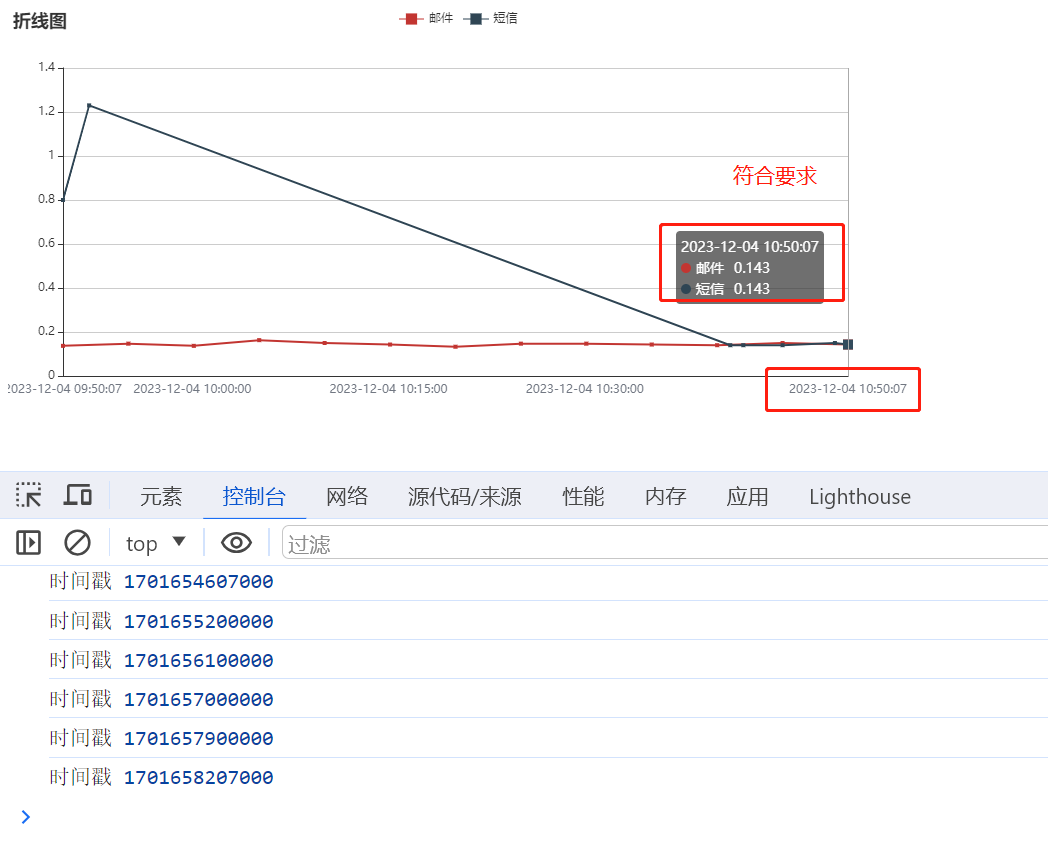
完整代码
多条折线图
function backTime(value){
let date = new Date(value);
// 获取年份、月份和日期
let year = date.getFullYear();
let month = date.getMonth() + 1; // 月份从 0 开始,需要加 1
let day = date.getDate();
let hours = date.getHours();
let minutes = date.getMinutes();
let seconds = date.getSeconds();
// 格式化月份和日期为两位数(不足两位时补零)
month = month < 10 ? '0' + month : month;
day = day < 10 ? '0' + day : day;
hours = hours < 10 ? '0' + hours : hours;
minutes = minutes < 10 ? '0' + minutes : minutes;
seconds = seconds {
let str = ''
let temp = {
showTime: '', // 时间
marker: '', // 颜色
seriesName: '', // legend名称
valueData: '', // 数值
setWidthSpan: '',
}
c.forEach((item) => {
temp.showTime = item.data[0]
temp.marker = item.marker
temp.seriesName = item.seriesName
temp.valueData = item.value[1]
temp.setWidthSpan = ''
str += temp.marker + temp.seriesName + temp.setWidthSpan + temp.valueData + '
'
})
return temp.showTime + '
' + str
},
},
legend: {
data: ['邮件', '短信']
},
// 网格间距设置
grid: {
left: '30px',
right: '60px',
bottom: '3%',
containLabel: true
},
xAxis: {
// xAxis的下不在设置data属性共享时间`
type: 'time',
splitLine: { show: false },
lineStyle: {
width: 2
},
axisTick: {
show: false
},
axisLabel:{
// 更改x轴文字颜色的配置
textStyle: {
color: '#717782'
},
// 设置坐标轴上的时间格式
formatter: function (value) {
console.log('时间戳',value )
// 将时间转换为 JavaScript 日期对象
return backTime(value)
},
showMinLabel: true,
showMaxLabel: true // 固定显示X轴的最后一条数据
},
// 更改x轴线的颜色
axisLine: {
lineStyle: {
color: '#D2DBE6;',
width: 1 // x轴线的宽度
}
},
},
yAxis: {
type: 'value'
},
// 数据
series: [
{
"name": "邮件",
"type": "line",
"symbol": "rect",
"connectNulls": true,
"showAllSymbol": true,
// 让每一条折线拥有数据自己的时间
"data": [
[ "2023-12-04 09:50:07", "0.137"],
[ "2023-12-04 09:55:07", "0.147"],
[ "2023-12-04 10:00:07", "0.137"],
[ "2023-12-04 10:05:07", "0.163"],
[ "2023-12-04 10:10:07", "0.150"],
[ "2023-12-04 10:15:07", "0.143"],
[ "2023-12-04 10:20:07", "0.133"],
[ "2023-12-04 10:25:07", "0.147"],
[ "2023-12-04 10:30:07", "0.147"],
[ "2023-12-04 10:35:07", "0.143"],
[ "2023-12-04 10:40:07", "0.140"],
[ "2023-12-04 10:45:07", "0.150"],
[ "2023-12-04 10:50:07", "0.143"],
],
"unit": "%",
"markPoint": {
"symbol": "rect",
"symbolSize": "12",
"label": { "show": false },
"tooltip": { "triggerOn": "click", "trigger": "item" },
}
},
{
"name": "短信",
"type": "li服务器托管网ne",
"symbol": "rect",
"connectNulls": true,
"showAllSymbol": true,
"data": [
[ "2023-12-04 09:50:07", "0.8"],
[ "2023-12-04 09:52:07", "1.23"],
[ "2023-12-04 10:41:07", "0.140"],
[ "2023-12-04 10:42:07", "0.140"],
[ "2023-12-04 10:45:07", "0.140"],
[ "2023-12-04 10:49:07", "0.150"],
[ "2023-12-04 10:50:07", "0.143"],
],
"unit": "%",
"markPoint": {
"symbol": "circle",
"symbolSize": "12",
"label": { "show": false }
}
}
]
};
myChart.setOption(option);
服务器托管,北京服务器托管,服务器租用 http://www.fwqtg.net
机房租用,北京机房租用,IDC机房托管, http://www.fwqtg.net
服务器服务器托管网托管,北京服务器托管,服务器租用 http://www服务器托管网.fwqtg.net相关推荐: 基于深度学习的文本分类6大算法-原理、结构、论文、源码打包分享导读:文本分类是NLP领域一项基础工作,在工业界拥有大量且丰富的应用场景。传统的文…

